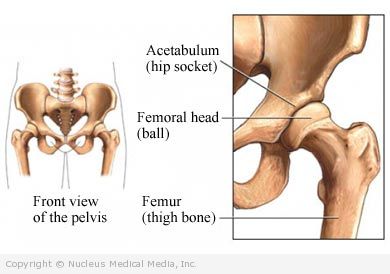(Dislocated Hip; Dislocation, Hip)
Hip dislocation – Definition
A hip dislocation occurs when the ball of the thighbone (femur) moves out of place within the socket of the pelvic bone (acetabulum). This ball and socket forms the hip joint.
Hip dislocation – Causes
Hip dislocations are relatively rare and severe injuries. They are often associated with pelvic fractures. A normal hip joint is stable and strong. A hip dislocation can only occur when a strong force is applied to the hip joint, such as:
- Severe falls, especially from heights
- Motor vehicle accidents
- Sports injuries
Hip dislocation – Risk Factors
These factors increase your chance of developing this condition. Tell your doctor if you have any of these:
- Prior hip replacement surgery
- Abnormal hip joint
- Alcohol use
- Poor muscle control or weakness leading to falls
Hip dislocation – Symptoms
Symptoms include:
- Severe pain in the hip, especially when attempting to move the leg
- Leg on the affected side appears shorter than the other leg
- Hip joint appears deformed
- Pain or numbness along the sciatic nerve area (back of thighs) if injury presses on this nerve
Hip dislocation – Diagnosis
The doctor will ask about your symptoms, how the injury occurred, and will examine your hip and leg.
Tests may include:
- X-ray — a test that uses radiation to take a picture of structures inside the body, especially bones
- CT scan — a type of x-ray that uses a computer to make pictures of structures inside the body, used to view fractures of the pelvis
Hip dislocation – Treatment
Treatments include:
Closed Reduction
The doctor will manipulate the thigh and leg. This is to try to put the ball of the femur back into the hip socket. You may be given medications to relax, such as:
- Pain medication
- Sedation
- Muscle relaxants
- General or spinal anesthesia
Open Reduction
In some cases, surgery is needed. Open reduction is often done if the thigh or pelvic bones are also broken.
Hip dislocation – Prevention
There are no guidelines for preventing hip dislocation. Most come from car accidents or sports injuries. To reduce your risk, take the following steps:
- Wear your seat belt in the car.
- Obey speed limits and other traffic laws.
- Do not drink and drive.
- Wear proper safety equipment for sports.

